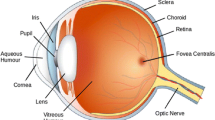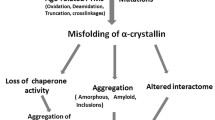Astract
Several amino acids were found to undergo progressive age-dependent racemisation in the lifelong proteins of normal human lenses. The two most highly racemised were Ser and Asx. By age 70, 4.5% of all Ser residues had been racemised, along with >9% of Asx residues. Such a high level of inversion, equivalent to between 2 and 3 d - amino acids per polypeptide chain, is likely to induce significant denaturation of the crystallins in aged lenses. Thr, Glx and Phe underwent age-dependent racemisation to a smaller degree. In model experiments, d - amino acid content could be increased simply by exposing intact lenses to elevated temperature. In cataract lenses, the extent of racemisation of Ser, Asx and Thr residues was significantly greater than for age-matched normal lenses. This was true, even for cataract lenses removed from patients at the earliest ages where age-related cataract is observed clinically. Racemisation of amino acids in crystallins may arise due to prolonged exposure of these proteins to ocular temperatures and increased levels of racemisation may play a significant role in the opacification of human lenses.









Similar content being viewed by others
References
Al-Ghadyan C (1986) Rise in lens temperature on exposure to sunlight or high ambient temperature. Br J Ophthalmol 70:421–426
Buckingham RH (1972) The behaviour of reduced proteins from normal and cataractous lenses in highly dissociating media: a cross-linked protein in cataractous lenses. Exp Eye Res 14:123–129
Capasso S, Di Cerbo P (2000) Kinetic and thermodynamic control of the relative yield of the deamidation of asparagine and isomerization of aspartic acid residues. J Pept Res 56:382–387
Cheng R, Feng Q, Argirov OK, Ortwerth BJ (2004) Structure elucidation of a novel yellow chromophore from human lens proteins. J Biol Chem 279:45441–45449
Clarke S (1987) Propensity for spontaneous succinimide formation from aspartyl and asparaginyl residues in cellular proteins. Int J Pept Protein Res 30:808–821
Cloos P, Christgau S (2002) Non-enzymatic covalent modifications of proteins: mechanisms, physiological consequences and clinical applications. Matrix Biol 21:39–52
Cloos P, Jensen A (2000) Age-related de-phosphorylation of proteins in dentin: a biological tool for assessment of protein age. Biogerontology 1:341–356
Collins MJ, Waite ER, van Duin ACT (1999) Predicting protein decomposition: the case of aspartic acid racemization kinetics. Philos Trans R Soc Lond 354:51–64, Series B: Biological Sciences
Di Salvo ML, Delle Fratte S, Maras B, Bossa F, Wright HT, Schirch V (1999) Deamidation of asparagine residues in a recombinant serine hydroxymethyltransferase. Arch Bioch Biophys 372:271–279
Fagerholm P, Philipson B, Lindström B (1981) Normal human lens—the distribution of protein. Exp Eye Res 33:615–620
Fujii N, Momose Y, Harada K (1996) Kinetic study of racemization of aspartyl residues in model peptides of alpha A-crystallin. Int J Pept Protein Res 48:118–122
Fujii N, Harada K, Momose Y, Ishii N, Akaboshi M (1999a) d-Amino acid formation induced by a chiral field within a human lens protein during aging. Biochem Biophys Res Commun 263:322–326
Fujii N, Takemoto LJ, Momose Y, Matsumoto S, Hiroki K, Akaboshi M (1999b) Formation of four isomers at the Asp-151 residue of aged human [alpha]A-crystallin by natural aging. Biochem Biophys Res Commun 265:746–751
Garner WH, Spector A (1978) Racemization in human lens: evidence of rapid insolubilization of specific polypeptides in cataract formation. Proc Natl Acad Sci USA 75:3618–3620
Garner WH, Spector A (1980) Selective oxidation of cysteine and methionine in normal and senile cataractous lenses. Proc Natl Acad Sci USA 77:1274–1277
Geiger T, Clarke S (1987) Deamidation, isomerization, and racemization at asparaginyl and aspartyl residues in peptides. Succinimide-linked reactions that contribute to protein degradation. J Biol Chem 262:785–794
Hains PG, Truscott RJW (2010) Age-dependent deamidation of life-long proteins in the human lens. Invest Ophthalmol Vis Sci. doi:10.1167/iovs.09-4308
Harding EF (1984) An efficient, minimal storage procedure for calculating the Mann–Whitney U, generalized U and similar distributions. J Roy Statist Soc Ser C 33:1–6 (Appl. Statist.)
Harding J (1991) Cataract: biochemistry, epidemiology and pharmacology. Chapman and Hall, London
Helfman PM, Bada JL (1975) Aspartic acid racemization in tooth enamel from living humans. Proc Natl Acad Sci USA 72:2891–2894
Heys KR, Truscott RJW (2008) The stiffness of human cataract lenses is a function of both age and the type of cataract. Exp Eye Res 86:701–703
Heys KR, Friedrich MG, Truscott RJW (2007) Presbyopia and heat: changes associated with aging of the human lens suggest a functional role for the small heat shock protein, alpha-crystallin, in maintaining lens flexibility. Aging Cell 6:807–815
Heys KR, Friedrich MG, Truscott RJW (2008) Free and bound water in normal and cataractous human lenses. Invest Ophthalmol Vis Sci 49:1991–1997
Kaufman DS, Manley WF (1998) A new procedure for determining dl amino acid ratios in fossils using reverse phase liquid chromatography. Quatern Sci Rev 17:987–1000
Korlimbinis A, Truscott RJW (2006) Identification of 3-hydroxykynurenine bound to proteins in the human lens. A possible role in age-related nuclear cataract. Biochem J 45:1950–1960
Kuge K, Brack A, Fujii N (2007) Conformation-dependent racemization of aspartyl residues in peptides. Chem Eur J 13:5617–5621
Lapko VN, Smith DL, Smith JB (2001) In vivo carbamylation and acetylation of water-soluble human lens alphaB-crystallin lysine 92. Protein Sci 10:1130–1136
Lapko VN, Smith DL, Smith JB (2003) Methylation and carbamylation of human gamma-crystallins. Protein Sci 12:1762–1774
Linetsky M, Hill JMW, LeGrand RD, Hu F (2004) Dehydroalanine crosslinks in human lens. Exp Eye Res 79:499–512
Lynnerup N, Kjeldsen H, Heegaard S, Jacobsen C, Heinemeier J (2008) Radiocarbon dating of the human eye lens crystallines reveal proteins without carbon turnover throughout Life. PLoS ONE :1529-1531
MacCoss MJ, McDonald WH, Saraf A, Sadygov R, Clark JM, Tasto JJ, Gould KL, Wolters D, Washburn M, Weiss A, Clark JI, Yates JR III (2002) Shotgun identification of protein modifications from protein complexes and lens tissue. Proc Natl Acad Sci USA 99:7900–7905
Maroudas A, Palla G, Gilav E (1992) Racemization of aspartic acid in human articular cartilage. Connect Tissue Res 28:161–169
Masters P, Bada J, Zigler J (1977) Aspartic acid racemisation in the human lens during ageing and in cataract formation. Nature 268:71–73
Masters PM, Bada JL, Zigler JS (1978) Aspartic acid racemization in heavy molecular weight crystallins and water insoluble protein from normal human lenses and cataracts. Proc Natl Acad Sci USA 75:1204–1208
Nagaraj RH, Sell DR, Prabhakaram M, Ortwerth BJ, Monnier VM (1991) High correlation between pentosidine protein crosslinks and pigmentation implicates ascorbate oxidation in human lens senescence and cataractogenesis. Proc Natl Acad Sci USA 88:10257–10261
Nakamura T, Sakai M, Sadakane Y, Haga T, Goto Y, Kinouchi T, Saito T, Fujii N (2008) Differential rate constants of racemization of aspartyl and asparaginyl residues in human alpha A-crystallin mutants. Biochem Biophys Res Commun 1784:1192–1199
Paulus H (2000) Protein splicing and related forms of protein autoprocessing. Annu Rev Biochem 69:447–496
Pirie A (1968) Color and solubility of the proteins of human cataracts. Invest Ophthalmol Vis Sci 7:634–650
Powell J, Vine N, Crossman M (1992) On the accumulation of d-aspartate in elastin and other proteins of the ageing aorta. Atherosclerosis 97:201–208
Radkiewicz JL, Zipse H, Clarke S, Houk KN (2001) Neighboring side chain effects on asparaginyl and aspartyl degradation: an Ab initio study of the relationship between peptide conformation and backbone NH acidity. J Am Chem Soc 123:3499–3506
Ritz-Timme S, Collins MJ (2002) Racemization of aspartic acid in human proteins. Ageing Res Rev 1:43–59
Ritz S, Schutz HW (1993) Aspartic acid racemization in intervertebral discs as an aid to postmortem estimation of age at death. J Forensic Sci 38:633–640
Robinson NE, Robinson AB (2004) Molecular clocks: deamidation of asparaginyl and glutaminyl residues in peptides and proteins. Althouse Press, Cave Junction, OR
Roth GS, Lane MA, Ingram DK, Mattison JA, Elahi D, Tobin JD, Muller D, Metter JE (2002) Biomarkers of caloric restriction may predict longevity in humans. Sci 297:811
Schwartz B (1965) Environmental temperature and the ocular temperature gradient. Arch Ophthalmol 74:237–243
Schwass DE, Finley JW (1984) Heat and alkaline damage to proteins: racemization and lysinoalanine formation. J Agric Food Chem 32:1377–1382
Shapira R, Wilkinson KD, Shapira G (1988) Racemization of individual aspartate residues in human myelin basic protein. J Neurochem 50:649–654
Shapiro S, Endicott S, Province M, Pierce J, Campbell E (1991) Marked longevity of human lung parenchymal elastic fibers deduced from prevalence of d-aspartate and nuclear weapons-related radiocarbon. J Clin Invest 87:1828–1834
Spector A, Chiesa R, Sredy J, Garner W (1985) Camp-dependent phosphorylation of bovine lens alpha-crystallin. Proc Natl Acad Sci USA 82:4712–4716
Srivastava OP, Srivastava K (2003) Beta B2-crystallin undergoes extensive truncation during aging in human lenses. Biochim Biophys Acta 301:44–49
Stabler TV, Byers SS, Zura RD, Kraus VB (2009) Amino acid racemization reveals differential protein turnover in osteoarthritic articular and mensical cartilages. Arthritis Res Ther 11:34–42
Sund-Levander M, Forsberg C, Wahren LK (2002) Normal oral, rectal, tympanic and axillary body temperature in adult men and women: a systematic literature review. Scand J Caring Sci 16:122–128
Truscott RJW (2005) Age-related nuclear cataract—oxidation is the key. Exp Eye Res 80:709–725
Truscott RJW (2010) Are ancient proteins responsible for the age-related decline in health and fitness? Rejuvenation Res 13:83–89
Truscott RJW, Augusteyn RC (1977a) Changes in human lens proteins during nuclear cataract formation. Exp Eye Res 24:159–170
Truscott RJW, Augusteyn RC (1977b) Oxidative changes in human lens proteins during senile nuclear cataract formation. Biochim Biophys Acta 492:43–52
Van Den Oetelaar PJM, Van Beijsterveldt LEC, Van Beckhoven JRCM, Hoenders HJ (1986) Detection of aspartic acid enantiomers by chiral capillary gas chromatography: determination of in vivo racemization and reduction of metal induced background. J Chromatogr 368:135–143
Van den Oetelaar PJM, Hoenders HJ (1989) Racemization of aspartyl residues in proteins from normal and cataractous human lenses: an aging process without involvement in cataract formation. Exp Eye Res 48:209–214
Van Duin ACT, Collins MJ (1998) The effects of conformational constraints on aspartic acid racemization. Org Geochem 29:1227–1232
Verzijl N, DeGroot J, Oldehinkel E, Bank RA, Thorpe SR, Baynes JW, Bayliss MT, Bijlsma JW, Lafeber FP, Tekoppele JM (2000) Age-related accumulation of Maillard reaction products in human articular cartilage collagen. Biochem J 350:381–387
Wells-Knecht MC, Huggins TG, Dyer DG, Thorpe SR, Baynes JW (1993) Oxidized amino acids in lens protein with age. Measurement of o-tyrosine and dityrosine in the aging human lens. J Biol Chem 268:12348–12352
Wilmarth PA, Tanner S, Dasari S, Nagalla SR, Riviere MA, Bafna V, Pevzner PA, David LL (2006) Age-related changes in human crystallins determined from comparative analysis of post-translational modifications in young and aged lens: does deamidation contribute to crystalline insolubility? J. Proteome Res 5:2554–2566
Acknowledgements
The co-operation of Terry Lachlan and Colin Murray-Wallace at the University of Wollongong is gratefully acknowledged; in particular, assistance from Terry in running the HPLC was greatly appreciated. This study was supported by grants from the NIH (EY013570) and National Health and Medical Research Council (NHMRC) Grant 512334. RJWT is a NHMRC Senior Research Fellow. MH is the recipient of a Save Sight Institute PhD scholarship.
Author information
Authors and Affiliations
Corresponding author
About this article
Cite this article
Hooi, M.Y.S., Truscott, R.J.W. Racemisation and human cataract. d-Ser, d-Asp/Asn and d-Thr are higher in the lifelong proteins of cataract lenses than in age-matched normal lenses. AGE 33, 131–141 (2011). https://doi.org/10.1007/s11357-010-9171-7
Received:
Accepted:
Published:
Issue Date:
DOI: https://doi.org/10.1007/s11357-010-9171-7




